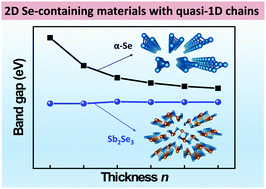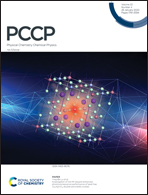Diverse electronic properties of 2D layered Se-containing materials composed of quasi-1D atomic chains†
Abstract
The two-dimensional (2D) atomically thin layered materials have attracted significant attention for constructing next-generation integrated electronic and optoelectronic devices. A special class of 2D materials composed of quasi one-dimensional (1D) atomic chains that show intriguing properties are less studied. Here, two Se-containing 2D layered materials α-Se and Sb2Se3 that have quasi-1D atomic chains are investigated via first-principles electronic structure calculations. Results shows that the electronic properties of n-monolayers (n-MLs) stacked α-Se and Sb2Se3 exhibit distinct layer-dependence electronic properties. The band gap of 2D α-Se remarkably decreases with increasing thickness, whereas the band gap of 2D Sb2Se3 show negligible change with thickness. The evolution of lattice phonon frequencies with thickness also show similar distinction. The underpinnings of the diverse electronic properties are attributed to the different electronic coupling among the layers of α-Se and Sb2Se3 that results in different van der Waals interactions among chains/layers. Our study demonstrates the rich diversity in the properties of 2D layered materials composed of lower-dimensional structural motifs.



 Please wait while we load your content...
Please wait while we load your content...